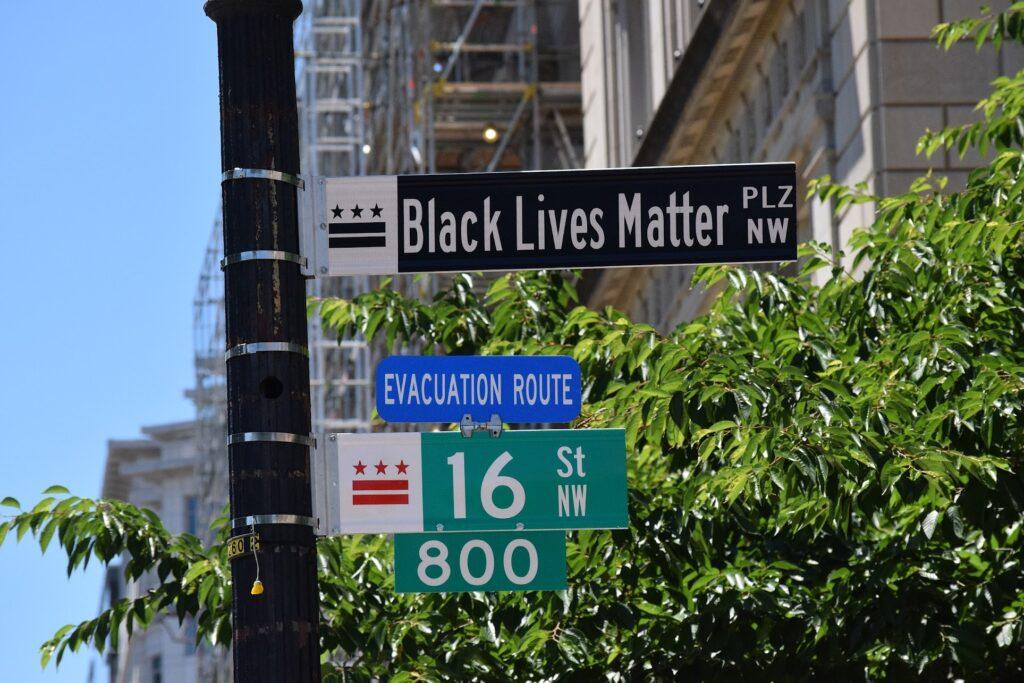The bold yellow letters that make up Black Lives Matter Plaza are now permanently part of the Washington, D.C. cityscape.
The permanent installation, spanning two blocks of 16th Street NW in front of the White House, consists of the words “Black Lives Matter” in yellow-painted concrete. Mayor Muriel Bowser (D) announced the completion of Black Lives Matter Plaza, made up of the yellow lettering, two opposing traffic lanes and a pedestrian plaza between the lanes, on Oct. 28. Because the mural faded in the months following its initial installation, city officials have now made the lettering permanent by applying a layer of thermoplastic paint designed to withstand weather conditions and fading.

The mural demonstrates that people have the power to enact change, and its permanent installation further solidifies that belief, Bowser said in an Oct. 28 press release.
“When we created Black Lives Matter Plaza in June 2020, we sent a strong message that Black Lives Matter, and that power has always been and always will be with well-meaning people,” Bowser said in the press release. “Today, we have transformed the mural into a monument.”
Bowser initially declared the section of the street “Black Lives Matter Plaza” in June 2020 after the National Guard violently forced peaceful protestors to leave the area so that former President Donald Trump could take a picture holding a Bible.
Black Lives Matter Plaza, and the identical murals it inspired in over 19 other cities, shows the impact the mural had on a global movement, according to Keyonna Jones, founder and executive director of Congress Heights Arts and Culture Center and one of the eight artists originally commissioned by the District to paint the mural in 2020.
“Healing starts in an internal space, and then it moves into a communal space, and then it becomes global,” Jones said in a phone interview with The Hoya. “I think the moment of the mural, and how it replicated across the world, showed exactly that.”
Some activist groups, like the D.C. chapter of Black Lives Matter, called the original mural at Black Lives Matter Plaza an example of performative activism that detracts from Bowser’s lack of substantive reforms to the District’s criminal justice system, which routinely subjects Black D.C. residents to harsher sentences and unfair convictions.
According to Bowser in the press release, the permanent installation of the mural signifies the progress that has been made and the work still left to do.
“One of my proudest memories of Black Lives Matter Plaza is when, in his final days, Congressman John Lewis came to see it for himself,” Bowser said in the press release. “He recognized Black Lives Matter Plaza as good trouble, and we know it will remain a gathering place for reflection, planning and action, as we work toward a more perfect union.”
The District spent $4.8 million thus far in its efforts to make the mural at Black Lives Matter Plaza permanent. Future changes aimed at making the area more accessible are forthcoming, according to the press release.
“In the coming months, an additional $3 million investment will create a more cohesive public space around the monument by reconstructing nearby sidewalks, installing commemorative works, and adding new benches, lighting, signage, and street trees,” the press release reads.
According to Jones, by making the mural a permanent installation, the message and goal of the Black Lives Matter movement will be remembered.
“I hope that people are reminded about what that time was like and how art was able to shift the paradigm and to understand that art is history,” Jones said. “If we didn’t have these artifacts, or if we didn’t have these moments, these monuments and these sculptures, a lot of the things that hadn’t been written down would probably be lost in history.”




















